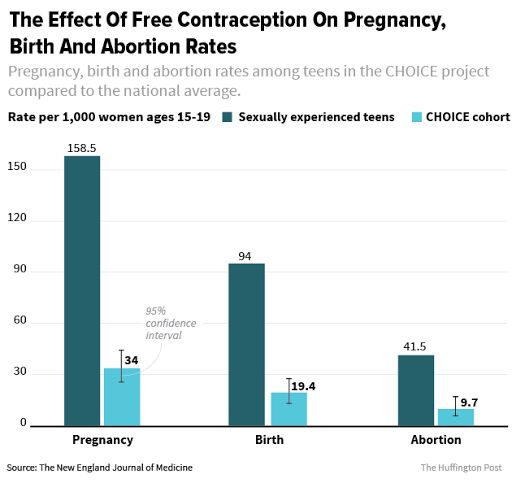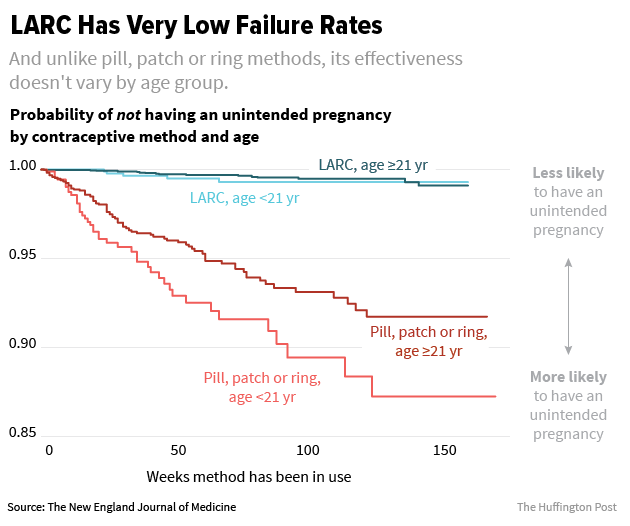Based on the rash of recent statewide anti-abortion laws, you’d never guess that the U.S. is winning the fight to reduce unintended pregnancies. Abortions in the U.S. are at the lowest rate since the Roe v. Wade decision in 1973, while teen birth rates are the lowest they’ve ever been since the country started recording that data.
Despite this, in 2016, 19 states passed more than 60 restrictions on abortion. And 2017 is starting to offer more of the same: Kentucky passed a bill banning abortion after 20 weeks and Arkansas just passed a law that allows a man to stop his wife from having an abortion if he is the father of the fetus.
Supporters of these laws believe that outlawing certain abortion procedures protects the mental and physical health of the mother and the fetus’ right to thrive and be born. For those who believe abortion is murder, these laws seem like they should reduce the number of abortion procedures carried out every year.
But research from around the globe is sobering: Restrictive laws don’t actually seem to reduce abortion rates. Instead, they are linked to unsafe abortions, which put women at risk of serious health problems and even death.
It doesn’t have to be like this. There are known, evidence-based ways to reduce abortions that actually increase a woman’s autonomy over her body, health and well-being — rather than take away her rights and put her in danger.

When states invest in comprehensive sex education, teen pregnancy rates go down.
States that emphasize abstinence-only programs have the highest rates of teen pregnancy and teen birth. And while research also shows that students who go through abstinence-only programs or take virginity pledges appear to have fewer sexual partners and be sexually active for less time, they still have the same rates of STD infection as their non-pledging peers ― possibly because they are less likely to use condoms at first, or get tested for STDs.
It’s important to note that these trends are only a correlation, says Dr. Laura MacIsaac, system director of the division of family planning at Mount Sinai Health System in New York. In other words, they don’t definitively demonstrate that abstinence-only education causes higher rates of teen pregnancy or teen births. Due to the lack of randomized controlled trials on this issue, however, they are some of the few measures of how successful particular sex education programs are.
California is one example of how states have adjusted when it becomes clear that abstinence-only education isn’t working. In 1992, the state’s teen pregnancy rate was 157 per 1,000 teens aged 15 to 19 — the highest rate in the nation. To combat the problem, the state launched a three-year abstinence-only sex education effort, only to cancel the program in 1995 when it had absolutely no effect on teens’ decisions to start having sex. In 2003, lawmakers instead passed the California Comprehensive Sexual Health and HIV/AIDS Prevention Education Act, explains Heather D. Boonstra in a 2010 article for the Guttmacher Policy Review.
The law, Boonstra explained, forbade classes from promoting religious doctrine or bias against people, and said that all sex education programs had to be medically accurate, age-appropriate and comprehensive. By 2005, California’s teen pregnancy rate was 75 per 1,000 teens ― a more than 50 percent decline that dwarfed the corresponding national decline of 37 percent.
To this day, a large minority of teen pregnancies tend to end in abortion. But with California’s decline in teen pregnancy rates came declines in both teen births and teen abortions. Abortions, in particular, dropped from 76 per 1,000 teens in 1988 to 26 per 1,000 in 2005.
In contrast to California, Texas only began shifting away from abstinence-only education around 2011, soon after the end of the George W. Bush administration, when federal grant money for abstinence-only programs dried up. By then, Texas had the third-highest teen pregnancy rate in the country, and the Barack Obama administration was offering funding for “evidence-based” teen sex education.
In 1990, Texas and California were basically on equal footing when it came to teen births: Texas’ teen birth rate was 75.3 per 1,000 teen girls, while California’s teen birth rate was 70.6 per 1,000. Yet by 2011, Texas’ teen birth rate was 46.9 per 1,000 teen girls, while California’s was only 28.7 per 1,000.
By 2014, the latest year for which this data is available, the teen birth rate in Texas was 37.8 per 1,000 teen girls, while California’s was 21.1 per 1,000.
When teens have access to the free birth control of their choice, abortion rates plummet.
The Contraceptive CHOICE Project launched in St. Louis, Missouri in 2007 with the goal of reducing unintended pregnancies. A large proportion of unintended pregnancies, which are defined as either mistimed or unwanted, tend to end in abortion; In 2011, about 45 percent of pregnancies in the U.S. were unintended, of which 42 percent ended in abortion.
To prevent such pregnancies, the CHOICE project enrolled over 9,000 women between 2007 and 2011 to receive free contraceptive counseling and the contraception of their choice for two to three years. The researchers found that from 2006 to 2010, teen study participants had an average annual abortion rate of 9.7 per 1,000 teens — significantly lower than the 41.5 abortions per 1,000 sexually active teens nationwide in 2008.

“The idea that women can access preventive methods and preventive health care at low cost or no cost is essential,” said lead investigator Dr. Jeffrey Peipert, chair of the department of obstetrics and gynecology at Indiana University School of Medicine. “Every dollar invested in contraception can save between four and 17 dollars down the road in health care costs.”
MacIsaac, who was not involved in Peipert’s research, described the CHOICE project as “the most powerful study we have of what works: education of the methods and free access.”
The state of Colorado has also found this to be true. After handing out free IUDs and implants to teens and poor women over six years, the statewide teen birthrate dropped 40 percent from 2009 to 2013, while the abortion rate dropped 42 percent. The results were especially dramatic in the state’s poorest regions, The New York Times reported.
Despite the program’s stunning success, however, GOP members in Colorado’s state Senate failed to keep funding it when the money ran out in 2015. Colorado corrected this when Gov. John Hickenlooper (D) signed the state’s 2016 budget, however, providing $2.5 million for the program.
Long-acting, reversible contraception is the most effective way to prevent teen pregnancy ― but it needs to be affordable.
Short of sterilization ― which is permanent ― the use of long-acting, reversible contraception (known as LARCs) is the most effective way to prevent pregnancy. LARCs, which include IUDs and implants, last for years and don’t require woman to remember to take a daily pill, slap on a monthly patch or use condoms.
LARCs are highly effective and cheaper over the long term, but they can be expensive up front for uninsured or underinsured women. Out-of-pocket costs can range from $500 to $1,000, putting them out of reach for teens and poor women — those most at risk of an unintended pregnancy.
In the contraceptive CHOICE project, teen participants learned about all methods of contraception, including LARCs. Seventy-two percent of the teens then chose to use an IUD or an implant as their own form of birth control. Among the general population, only 7.2 percent of women use LARCs. This shows that women who receive a comprehensive education about birth control methods are more likely to choose the most effective and long-lasting kind.
Among the CHOICE participants who opted not to use LARCs as their birth control method, there were 4.55 unintended pregnancies per 100 women every year. There were only 0.27 unintended pregnancies per 100 women per year for the CHOICE participants who chose the LARCs.

Based on this and similar data, the American College of Obstetricians and Gynecologists urged doctors to consider recommending LARCs as the first-line contraceptive for both women and teens in 2012. ACOG re-emphasized this recommendation in 2015, urging doctors to encourage patients to consider LARCs and advocate for patients to get insurance to cover the devices.
“One of the reasons ACOG is trying to improve physician education around LARC is because we have so much more robust data about how good contraception is highly effective and easy to use, and that women like it,” said MacIsaac, who also serves on ACOG’s LARC task force. “We’ve known it all over Europe, the CHOICE study showed it in the U.S., and ACOG wants to help push that information forward.”
Outlawing abortion endangers women and doesn’t seem to work.
Meanwhile, in contrast to these evidence-based methods of reducing unintended pregnancy, research suggests that outlawing abortion procedures doesn’t actually help reduce abortion.
A 2016 analysis published in the Lancet finds that the average abortion rate in countries where the procedure is outlawed is 37 per 1,000 women, compared to 34 per 1,000 in countries where abortion is legal. In other words, scientists found no evidence that anti-abortion laws do anything to reduce the number of actual procedures women get.
The analysis also found that abortion rates are down worldwide, from 40 per 1,000 women in 1994 to 35 per 1,000 women by 2014. However, the decrease is concentrated mostly in the developed world, where the rate declined from 46 abortions per 1,000 women to 27 per 1,000.
Countries in the developing world, meanwhile, saw abortions go down from 39 per 1,000 women to 37 per 1,000 — what scientists described as a “non-significant” decline. It’s worth noting that developed countries are more likely to have better access to health care and highly effective birth control than developing countries.
This reporting is brought to you by HuffPost’s health and science platform, The Scope. Like us on Facebook and Twitter and tell us your story: scopestories@huffingtonpost.com.
